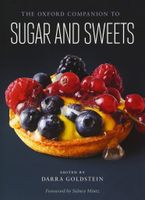Sugar is the primary building material of dessert. Even before the idea of this separate and final course fully evolved, a tenth-century Arab recipe described marzipan shaped like fish and perfumed with camphor. See marzipan and middle east. In early Renaissance Italy, Leonardo da Vinci wrote in Notes on Cuisine of the fate of his marzipan: “I have observed with pain that my Signor Ludovico and his court gobble up all the sculptures I give them, right to the last morsel, and now I am determined to find other means that do not taste as good, so that my works may survive.” The ultimate luxury commodity, his chosen medium of sugar was preservable, malleable, and believed to have medicinal properties. See medicinal uses of sugar. And (unfortunately for Leonardo’s sculpture), it was edible! Symbolically, technically, and gastronomically, sugar was the perfect material for public consumption—panem et circenses combined in one form.


